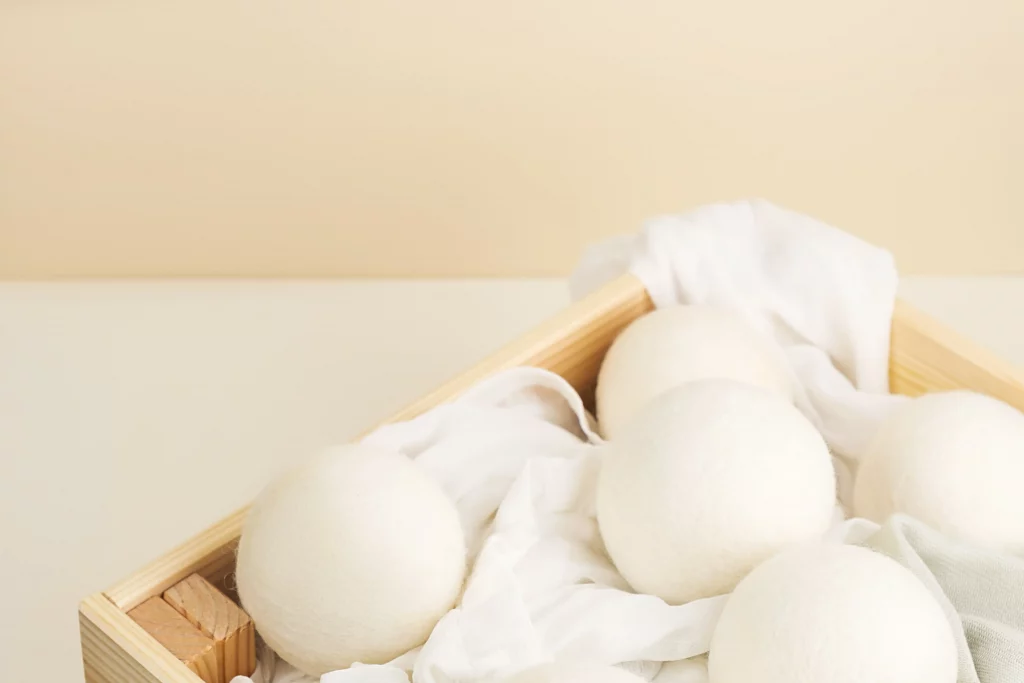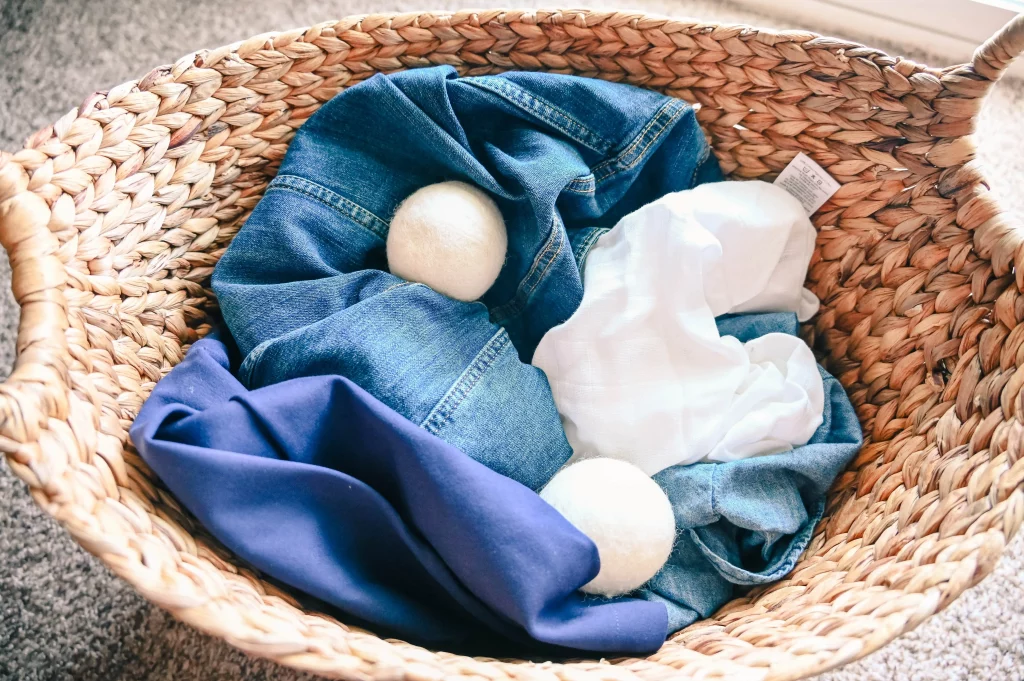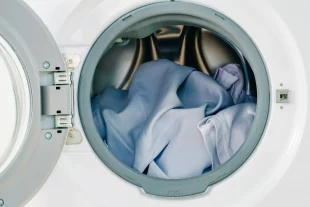 Get How-To's
Get How-To'sGarment Guides
The Power of Wool Dryer Balls

What Are Wool Dryer Balls
Laundry day blues are all too common – clothes emerging damp, wrinkles that seem impossible to banish, and the static cling that leaves you frustrated. If you find yourself searching for a quick and sustainable fix, we have the answer: wool dryer balls.
Unlike traditional fabric softeners and dryer sheets, these tightly woven spheres of felted wool offer a unique solution to softening clothes, reducing drying times and getting rid of static cling. In this comprehensive guide, we’ll explore the wonders of wool dryer balls, uncover how do dryer balls work, and delve into why they’re a superior alternative for a more efficient and eco-friendly laundry routine and the benefits of wool dryer balls.
Understanding Wool Dryer Balls
Let’s explore the topic of wool dryer balls, shall we? These tightly woven balls made from felted wool are an excellent alternative to commercial fabric softeners, and are both natural and biodegradable, making them an eco-friendly option. One of the best things about them is that you can even make them at home!
Aside from their eco-friendly nature, wool dryer balls are crafted with simplicity but have enormous impacts on how we do our laundry. As we look into their composition, you’ll see just how they become agents of change in the way you do your laundry.
How Wool Dryer Balls Work
Ever wondered how those little wool balls can make a significant difference in your laundry? Unlike traditional fabric softeners, wool dryer balls bounce off the dryer drum and into the clothing during the drying process. This bouncing action facilitates increased air circulation, preventing pockets of moisture and ultimately reducing drying times.
Comparing this action to traditional fabric softeners and dryer sheets, it becomes evident why wool dryer balls are gaining popularity. They offer a more dynamic and natural approach to softening clothes, making them a favored choice among those seeking an efficient laundry solution.
Benefits of Wool Dryer Balls
The benefits of wool dryer balls extend far beyond just softening clothes. They can revolutionize your wash and fold laundry routine in several ways: faster drying times, softer clothing, and wrinkle and static prevention.
Reduction in Drying Times
The absorbent nature of wool plays a key role in reducing drying times. Wool effectively soaks up moisture from clothes, ensuring a more efficient and quicker drying process. It’s essential to note that drying times may vary based on the fabric types being dried.
Enhanced Softness of Clothes
As the wool dryer balls circulate in the dryer, they agitate the clothes, loosening fibers and resulting in garments that emerge feeling softer. This natural softening process offers a gentler alternative to chemical-laden fabric softeners, ensuring that your clothes remain cozy and comfortable against your skin.
Wrinkle Reduction and Prevention of Static Cling
One of the remarkable benefits of using wool dryer balls is the reduction in wrinkles and static cling. If you promptly remove your clothes when the drying time is finished, you’ll find them to be nearly wrinkle-free. The increased air circulation from the dryer balls means there’s less friction between clothes, resulting in less wrinkling and static.
How to Use Wool Dryer Balls Effectively
Maximizing the effectiveness of wool dryer balls requires proper usage techniques. Here’s a guide for properly using wool dryer balls, whether they are bought or homemade.
Quantity Matters
The quality of wool dryer balls can have a significant impact on their functionality. High-quality wool dryer balls are typically firmer and denser than lower-quality ones, which makes them more effective at absorbing moisture and reducing static cling.
They also tend to last longer and maintain their shape better, making them a more durable and cost-effective option in the long run. It’s important to choose wool dryer balls made from high-quality materials to ensure that they perform optimally and provide the best possible results.
Inspection and Readiness
Upon acquiring store-bought wool dryer balls, give them a quick inspection to ensure they are in good condition. While they may not require the same felting process as homemade ones, it’s essential to confirm their readiness for the dryer. The balls should feel firm to the touch, indicating that they are prepared for action.
Prepping for the Dryer
Before their debut in the dryer, take a moment to ensure the store-bought wool dryer balls are free from any loose fibers. This step prevents potential lint transfer onto your clothes during the drying cycle. A quick once-over will suffice, setting the stage for a seamless laundry experience.
The Felted Advantage
While store-bought options often come pre-felted, it’s beneficial to understand the advantages of this process. Felting ensures that the fibers are tightly bound together, enhancing the durability and effectiveness of the wool dryer balls. This felting advantage contributes to better agitation within the dryer drum, promoting increased air circulation for superior results.
Ready for Action
Once you’ve inspected and prepped them, you can just toss them into the dryer along with your wet laundry, and voila! They work their magic and help dry your clothes faster. The best part is that they are super simple to use and don’t require any additional effort. These woolen wonders are designed to seamlessly elevate your laundry experience without any added complexities.
Crafting Your Own Wool Dryer Balls
For individuals inclined towards a hands-on, eco-friendly approach, crafting your wool dryer balls is fulfilling. Follow this step-by-step guide for instructions to creating your own wool dryer balls:
- Gather Your Supplies: Assemble your materials – wool roving, a felting needle, and pantyhose. These readily available items are essential for creating your personalized wool dryer balls.
- Forming the Balls: Take a small portion of wool roving and roll it tightly into a compact ball. This initial step sets the foundation for your dryer balls.
- Felting Process: Employ the felting needle to puncture the wool ball repeatedly. This action encourages the fibers to intertwine, resulting in a robust and resilient ball formation.
- Repeat and Secure: Continue the process until you attain the desired size for your wool dryer balls. Place the finished balls in pantyhose to maintain their shape during felting, securing them for the next crucial step.
- Felt the Balls: Introduce the pantyhose-encased balls into the dryer, allowing them to undergo several cycles. This final phase ensures thorough felting, preparing the balls for effective use in your laundry routine.
Exercise caution, as emphasized by experts, to guarantee the wool balls are fully felted before their introduction to the dryer. Following these user-friendly steps transforms raw materials into eco-conscious, efficient laundry companions.
Comparing Costs: Store-Bought vs. Homemade Wool Dryer Balls
When contemplating the use of wool dryer balls, it’s important to take into account not only their effectiveness but also their affordability. To assist you in making an informed decision, let’s explore the typical expenses related to both pre-made and handmade wool dryer balls.
Store-Bought Wool Dryer Balls
While convenient, store-bought wool dryer balls usually come with a price tag reflecting the convenience and quality assurance they offer. The average cost can vary, ranging from a few dollars per ball to packaged sets that may be priced higher.
Homemade Wool Dryer Balls
Crafting your own wool dryer balls at home involves an initial investment in materials like wool roving, a felting needle, and pantyhose. The cost of these supplies can vary based on the quality and quantity you choose.
In weighing the average costs, consider not just the immediate expenses but also the long-term benefits of durability, sustainability, and the joy of creating a personalized laundry solution. Whether you opt for the convenience of store-bought or the DIY route, the investment in wool dryer balls pays off through energy savings, reduced fabric wear, and a more effective laundry routine.
Wool Dryer Balls Conclusion
As we conclude this extensive guide, it’s clear that wool dryer balls go beyond being a mere laundry accessory. They serve as a transformative solution, addressing common laundry issues like reducing drying times, softening clothes, and minimizing wrinkles.
By choosing wool dryer balls, you are not only adopting an eco-friendly and effective laundry routine, but you are also enjoying practical advantages such as softer and less wrinkled clothes. Whether you decide to make your own or purchase them from a store, the most crucial factor is how effectively you use them.
For those seeking professional laundry solutions, consider the expertise of CD One Price Cleaners. Experience the professional touch – explore CD One Price Cleaners’ wool dryer balls and transform your laundry routine today!
Wool Dryer Ball FAQ’s
This FAQ section addresses common queries related to wool dryer balls, providing additional insights for a better laundry experience:
Are wool dryer balls safe for all fabrics?
Wool dryer balls are generally safe for most fabrics. However, users are advised to exercise caution with delicate materials sensitive to heat or prolonged drying times.
How many dryer balls should I use per load?
For optimal results, it is recommended to use four wool dryer balls per load. This ensures effective air circulation, leading to reduced drying times, softer clothes, and minimized static cling.
Can I add essential oils to my wool dryer balls for fragrance?
While it’s possible to add essential oils for a pleasant fragrance, caution is advised. CD One Price Cleaners suggests applying oils sparingly to prevent potential staining on clothes.



